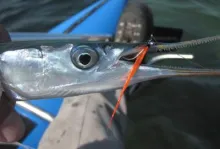In principle there's free and unlimited access to all coasts in Denmark. That's what the law says. But in many places reality is different.
One of the reasons for Denmark's coasts to be as attractive to the locals, tourists, anglers and many more is the fact that there's free access to the water basically everywhere.
Section 22 of “naturbeskyttelsesloven” (the law about protecting nature) states that "Beaches and other coastlines are open to traffic afoot, short-term stays and bathing on areas between daily low tide and the continuous land vegetation not dominated by salty plants or other coastal vegetation." (my translation)
In other words: you are allowed to walk on the beach on the part that's above the water when it's lowest and below any field, forest, lawn or other larger patches of land vegetation. That essentially leaves you a pretty wide band of freely accessible beach all along the coastline in Denmark.
And please notice, that this also allows you to walk in front of private land! This is not Malibou Beach or The Hamptons, fenced off from the public. You can swim (and fish) in front of these houses, and even sit down and eat your lunch if the houses are far enough away. You can't camp or stay all day, but passing by and taking a short rest is fully legal. A few military areas and nature sanctuaries have no access, but essentially all the rest is yours to explore.
|
|
|
|
|
|
|
|
|
|
|
|
|
|
|
|
|
|
|
|
|
|
|
|
That is a huge difference compared to many other countries, where you can ban people from entering or even passing by, and you can set up fences or walls and physically keep people from entering your land. That is not allowed in Denmark. As a land owner, you aren't allowed to obstruct or even just make it difficult to pass.
But… An acquaintance of mine, Anton Stonor, who is both a nature lover and a techie, heading a Danish web development company called Headnet, took a walk along the beach north of Copenhagen back in 2015.
This place is notoriously known for its expensive beach properties and for having an unsurpassed number of obstacles, making a walk more like a climb or a parkour trip.
Anton documented the trip by taking photos with short intervals and uploading them to the service Mapillary. This service will take your pictures and use their location data to place them on a map. It will also offer you to show the pictures as a “street view” like it's known from Google Maps. That allows the viewer to take a virtual walk along the path and experience what the originator saw.
If you walk in Anton's footpath and navigate with him up along the east coast of the island Sjaelland north of Copenhagen, you can get an impression of the obstacle course that Anton had to finish to get from A to B. Anton stopped about 30 kilometers north of Copenhagen, but along that stretch you will see numerous places where access is not exactly easy and a few places where you can say that the constructions are made to deter you from entering.
As already mentioned this area is known for its luxury houses and quite a few people wanting to keep what's theirs theirs. To be fair, Anton had no quarrels with the land owners he met on his trip. They were all kind and acknowledged his right to walk where he was walking.
A few places have signs saying “Private beach”, but most only mention that people are not allowed to stay on the beach for a longer time and does no prohibit them from passing.
This kind of development, where houses are built literally on the beach, is no longer allowed. Current development along the beaches must be done at least 300 meters or about 1000' from the water and even though dispensations are given, only few construction companies are allowed to build larger buildings close to the shore.
It's a battle between business people and politicians in the local communities on one side and nature lovers on the other. The first groups are convinced that summer houses, hotels, restaurants, amusement parks and other facilities close to the shore will appeal to people, while the second group thinks that it's exactly the lack of such facilities along the Danish beaches, which attracts so many visitors.
It's no secret that I belong to the second group. The fact that so much of the Danish coastline is undisturbed and protected, and still has public access, is precisely what makes it such a great attraction.
In my eyes it's a fantastic scoop and a great foresight by previous politicians that they ensured the protection of such a valuable asset, still allowing people access.
Anton's walk shows what beaches near larger cities could look like if development had just been left to the free market. After all: a lot of people want to live in a beach house, and prices on beach property has always been very high, so market forces had most likely made sure that both nature and access would have suffered if things had been left to develop without regulation.
Currently we only have a few places where houses have been built as close as this to the water, and they are allowed to remain there for historical reasons. The houses can also be demolished and rebuilt newer and better, but basically only where there has been a house for decades, and not larger or higher than the original house.
This keeps our beaches safe from development and being overrun by cities growing, even though there has been thoughts about lifting some of the restrictions and allowing communities to build certain facilities along the beaches.
- Log in to post comments
























